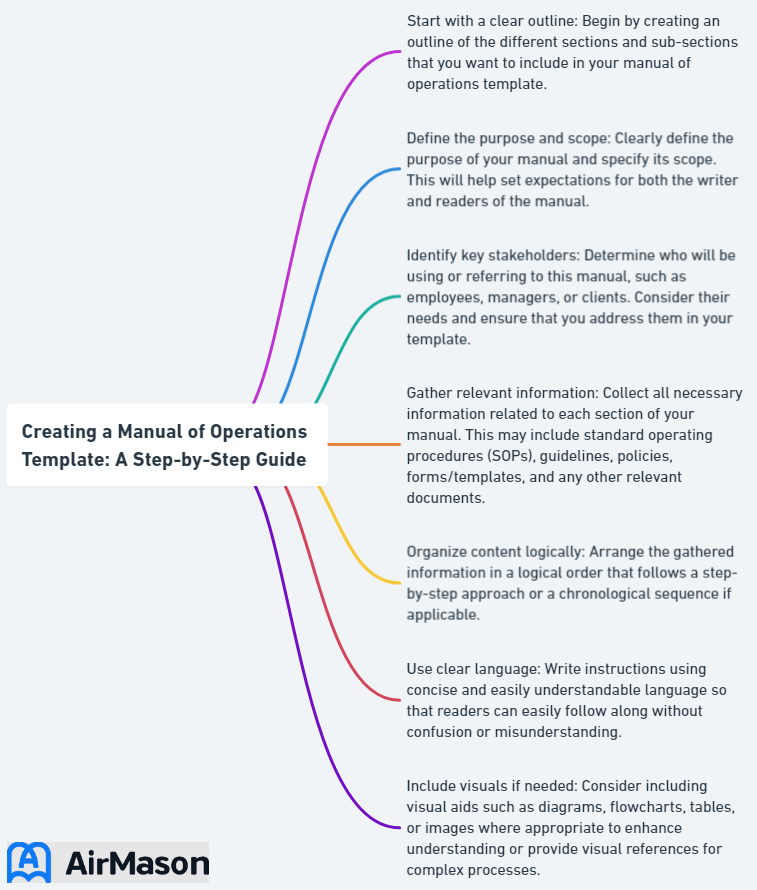
Have you ever wondered how successful businesses manage to maintain consistency, streamline their processes, and ensure employee satisfaction? The secret lies in a well-crafted manual of operations template. In this blog post, you will learn the importance of an operations manual, its key components, and how to create a manual of operations template that suits your organization’s needs, ensuring long-term success.
Dive in and discover how a manual of operations template can be a game-changer for your business, improving efficiency and providing a clear roadmap for employees at every level.
Key Takeaways
- Understand the importance of an operations manual and its key components.
- Create a comprehensive roadmap for employees by outlining company overview, policies & procedures, and job descriptions.
- Follow steps to plan, research, write content & customize your template before implementing it regularly.
Understanding the Importance of an Operations Manual
An operations manual plays a vital role in fortifying business consistency, streamlining processes, and offering employee training materials, which aids in ensuring long-term prosperity. Utilizing a financial operations manual template can be a cost-effective and time-saving strategy that also promotes swift idea generation and standardization, enhancing employee training capabilities.
Standardizing business processes offers several benefits, including:
- Reducing process uncertainty
- Ensuring quality
- Increasing efficiency
- Improving employee job satisfaction
With an operation manual, also known as a business operations manual, companies can provide a comprehensive guide for employees, ensuring adherence to company policies and procedures, and maintaining a high level of performance in their operations. In addition to these benefits, operations manuals also serve as valuable resources for training new employees and streamlining processes.

Key Components of an Operations Manual Template
An effective company operations manual template should include three key components: a company overview, policies and procedures, and job descriptions. These components provide a clear roadmap for employees, helping them understand their roles and responsibilities within the organization.
The upcoming sections will provide a detailed examination of each of these components, elucidating their significance and the requisite information for crafting a comprehensive and beneficial operations manual.
Company Overview
The company overview section plays a crucial role in introducing your organization to employees, providing a succinct introduction to your organization’s mission, vision, and values. This section should include essential information such as the company’s purpose, goals, and organizational structure, including an organizational chart.
A well-articulated company overview aids employees in grasping the company’s core values and their role in aligning with the organization’s broad objectives. This comprehension fosters an engaged and dedicated workforce, propelling the company towards success.
Policies and Procedures
Policies and procedures are the guidelines that dictate the operations of a company, ensuring consistent and high-quality performance across the entire organization. These guidelines encompass everything from daily tasks to emergency procedures and business policies, providing employees with a clear framework to follow.
Detailing policies and procedures in the operations manual allows businesses to forge a consistent and efficient process delivery, minimizing miscommunication and ambiguity. This strategy ultimately enhances productivity and customer satisfaction.
Job Descriptions
Job descriptions are essential for clearly defining the roles, responsibilities, and expectations for each position within the organization. They provide a detailed outline of the duties, qualifications, reporting structure, and performance expectations for each job, ensuring that employees are well-informed and focused on their specific tasks.
Incorporating precise and comprehensive job descriptions in your operations manual can markedly bolster employee engagement, satisfaction, and performance. Establishing clear expectations facilitates a better understanding of their roles within the company for employees, resulting in a more efficient and productive workforce.
Manual Procedures
Manual procedures are fundamental processes carried out by individuals or teams through direct human effort and expertise, often without automated or technological intervention. These procedures rely on human dexterity, skill, and understanding of specific tasks or operations. In various industries, manual procedures are essential for tasks that demand precision, flexibility, or subjective decision-making. Although technology has advanced significantly, certain tasks still require a hands-on approach due to their complexity, intricacy, or unique circumstances. Manual procedures play a vital role in fields such as healthcare, manufacturing, and artisanal craftsmanship, where human involvement ensures meticulous execution and adaptation to evolving situations. Balancing manual procedures with automation is crucial to optimize efficiency, maintain quality, and improve overall workflow in a modern, technology-driven world.
Choosing the Right Format for Your Operations Manual

Selecting the appropriate format for your operations manual is of utmost importance, as it can be a physical book, digital file, or an online platform, depending on the audience’s requirements. Each format has its own advantages and disadvantages, making it essential to consider your organization’s needs and the preferences of your employees.
For example, a physical book format may offer portability and tangibility, while a digital file or an online platform can provide easier updates and access for a mobile audience. Weighing the pros and cons of each format will help you choose the one that best suits your organization, ensuring a useful and accessible operations manual for everyone involved.
Steps to Create an Operations Manual Template

Creating an operations manual involves several steps, each crucial in ensuring the accuracy and clarity of the final document. These steps include:
- Planning and research
- Outlining the content
- Writing the content
- Reviewing and revising the document
The following subsections will dissect each of these steps, equipping you with a detailed guide for crafting an effective and comprehensive operations manual tailor-made for your organization’s needs.
Planning and Research

The first step in creating an operations manual is understanding your business processes, policies, job roles, and hierarchy. This involves:
- Identifying any pain points
- Determining which processes to include in the manual
- Utilizing tools like Scribe and the Business Process Incubator template.
A diligent approach to researching and planning your operations manual allows you to curate a comprehensive template that encompasses all vital facets of your organization. As a result, your manual becomes a valuable reference for employees, aiding them in effortlessly navigating their roles and responsibilities.
Outlining the Content

It is vital to outline the content for your operations manual to logically organize information and ensure coverage of all essential topics. This step involves visualizing processes through process maps, flowcharts, and BPMN diagrams, as well as utilizing process documentation and swimlane documentation to clarify who is responsible for various processes and the steps required to do so.
A well-structured outline will not only make the content creation process more manageable but also ensure that the final document is easy to navigate and understand for your employees.
Writing the Content

Writing the content for your operations manual requires clear and concise language, incorporating visuals and examples to aid understanding. This step involves recording processes, procedures, and policies, ensuring that the information is accurate and easy to comprehend.
Employing straightforward language and real-world examples enables the creation of an operations manual that is both informative and engaging, serving as a valuable resource for your employees.
Reviewing and Revising

The final step in creating an operations manual is reviewing and revising the document, ensuring accuracy and clarity. This involves obtaining feedback from team members, proofreading the manual for errors, and making necessary adjustments based on the input received.
Regularly reviewing and updating your operations manual ensures that it remains relevant, accurate, and useful for your employees. This continuous improvement process will help your organization maintain high standards and adapt to any changes in the business environment.
Organizational Manuals: Key Tools for Efficient Operations
Organizational manuals, also known as employee handbooks or company manuals, play a pivotal role in defining the structure, operations, and expectations within an organization. These manuals serve as comprehensive guides that elucidate the company’s mission, vision, policies, procedures, and cultural ethos. By outlining roles, responsibilities, and standard operating procedures, organizational manuals help align employees with the company’s objectives, ensuring smooth functioning and fostering a cohesive work environment. Furthermore, these manuals are essential for onboarding new team members, aiding in their assimilation into the organization and providing a clear roadmap for their professional conduct. Overall, organizational manuals act as foundational documents that contribute to organizational clarity, productivity, and unity.
Customizing Your Operations Manual Template
Customizing your operations manual template allows you to tailor it to your organization’s specific needs, branding, and industry requirements. This customization process involves incorporating your company’s logo, mission statement, and unique policies and procedures, ensuring that the manual accurately reflects your organization’s identity and values.
Personalizing your operations manual template results in a document that is not only informative but also visually appealing and engaging for your employees, enhancing its effectiveness as a training and reference tool.
Implementing and Updating Your Operations Manual
Implementing and updating your operations manual involves regular revisions and distribution through appropriate channels, ensuring that it remains relevant, accurate, and useful for employees. Assigning an owner to routinely audit and update the template, and communicating updates to all relevant stakeholders will help keep the manual current and effective.
Regular revisions and distributions of your operations manual guarantee that your employees have access to the most current information, empowering them to perform their jobs efficiently and comply with the company’s policies and procedures.
Templates for Training Manuals
Templates for training manuals provide a structured and organized framework for creating comprehensive and effective training materials. These templates serve as blueprints, guiding the content creation process to ensure that essential training topics are covered in a logical and coherent manner. Utilizing predefined templates streamlines the development process, saving time and effort while maintaining consistency across training materials. Key elements, such as training objectives, course outlines, instructional strategies, and assessment methods, are typically incorporated into these templates. This structured approach enhances the quality and efficiency of training manual creation, making it easier for trainers to deliver clear and impactful learning experiences to their audience.
Free and Premium Operations Manual Templates
If you’re looking to create a construction operations manual template, an emergency operations manual template, a hotel operations manual template, or a restaurant operations manual template, a variety of free operations manual templates are available to help you get started. These templates offer customizable designs, industry-specific content, and user-friendly formats, making it easy for you to create a manual tailored to your organization’s needs.
Irrespective of opting for a free or premium template, it’s important to tailor it to your organization’s requirements, ensuring its efficiency as a tool for employee training and reference.
Summary
In conclusion, an operations manual is an invaluable resource for businesses, helping to establish consistency, streamline processes, and provide employee training materials. By following the steps outlined in this blog post, you can create a comprehensive operations manual that meets your organization’s needs and ensures long-term success.
So, whether you’re starting from scratch or looking to update an existing manual, don’t underestimate the power of a well-crafted operations manual. It can be the key to unlocking your organization’s full potential and driving it towards greater success.
Frequently Asked Questions
How do you write an operations manual?
To write an operations manual, document processes and include business policies, draw up organizational hierarchy and job roles, explain your emergency response plan, choose the right creation tool and format, develop a layout, and receive feedback.
What should be in a company operations manual?
A company operations manual should include the company’s history, organizational structure, roles and responsibilities, policies and procedures, as well as its products and services.
Who prepares the operations manual?
The office manager, operations manager, or communications manager typically prepares the operations manual, requiring good writing skills, organization, and attention to detail.
How do I choose the right format for my operations manual?
When selecting the format for your operations manual, consider the needs of your organization and the preferences of your employees. Different formats such as a physical book, digital file, or an online platform each offer unique benefits and should be carefully considered.
What is the importance of planning and research when creating an operations manual?
Planning and research are essential for creating an effective operations manual, as they provide the necessary understanding of business processes, policies, job roles, and hierarchy for it to cover all necessary aspects of the organization.